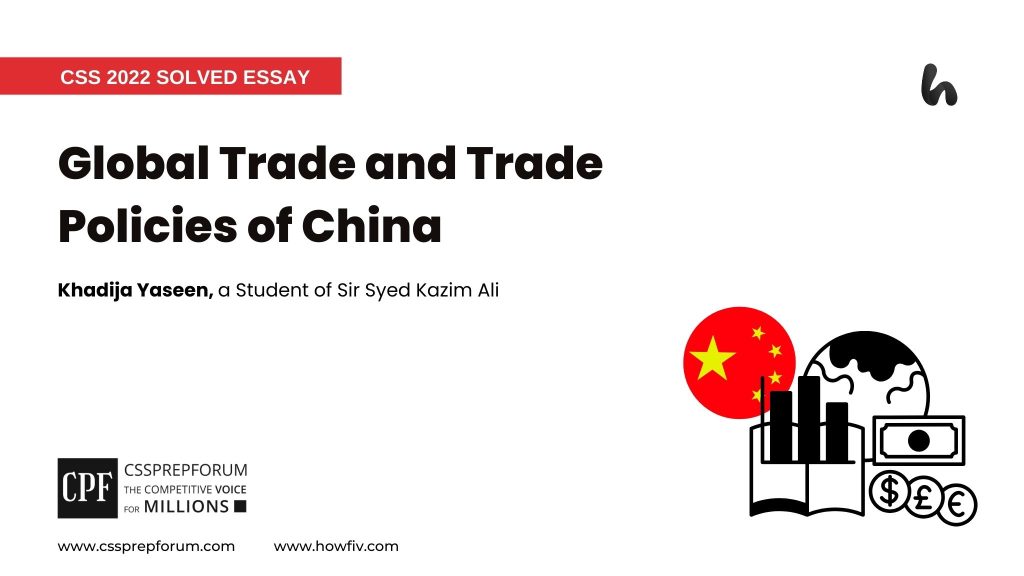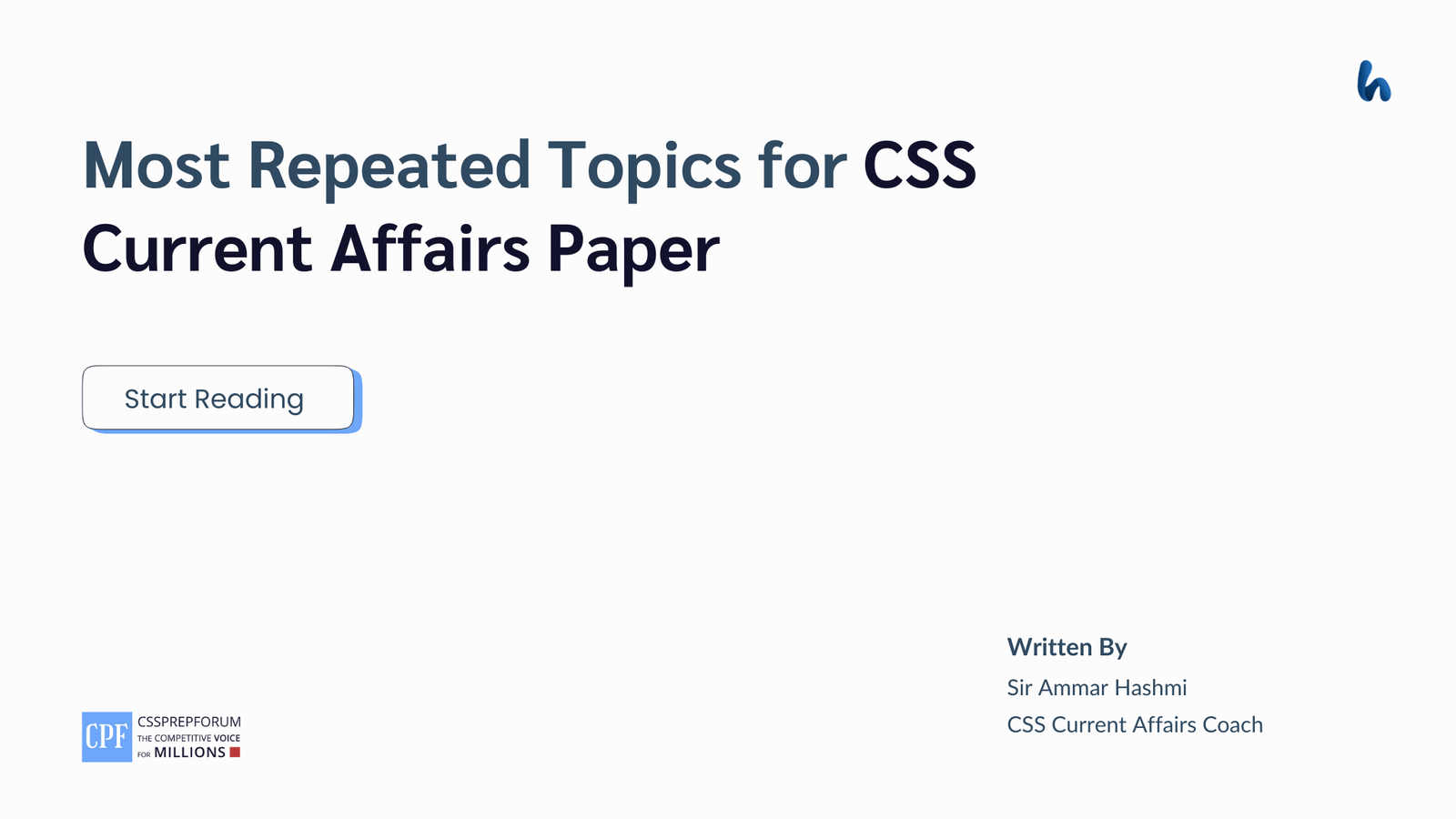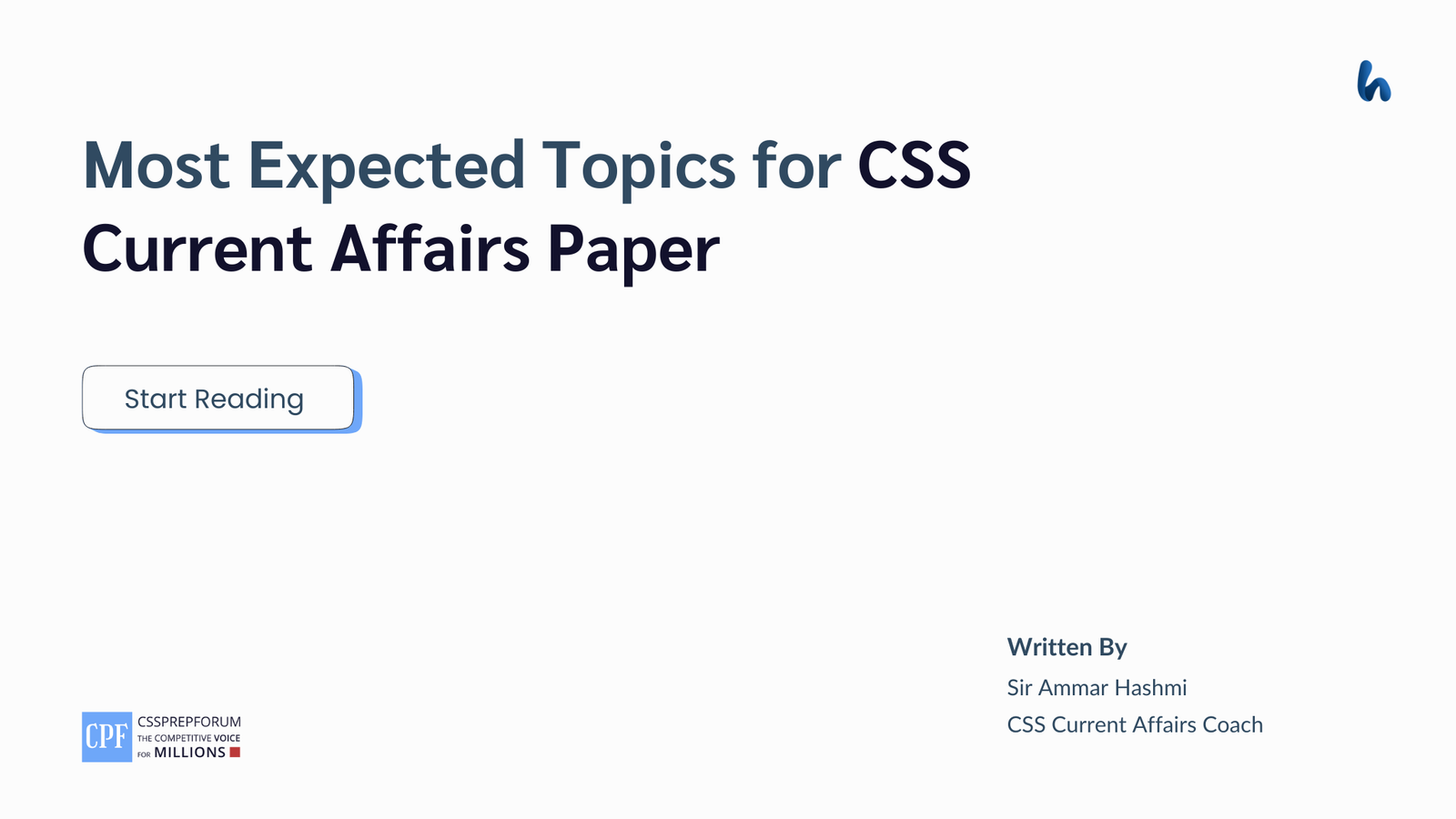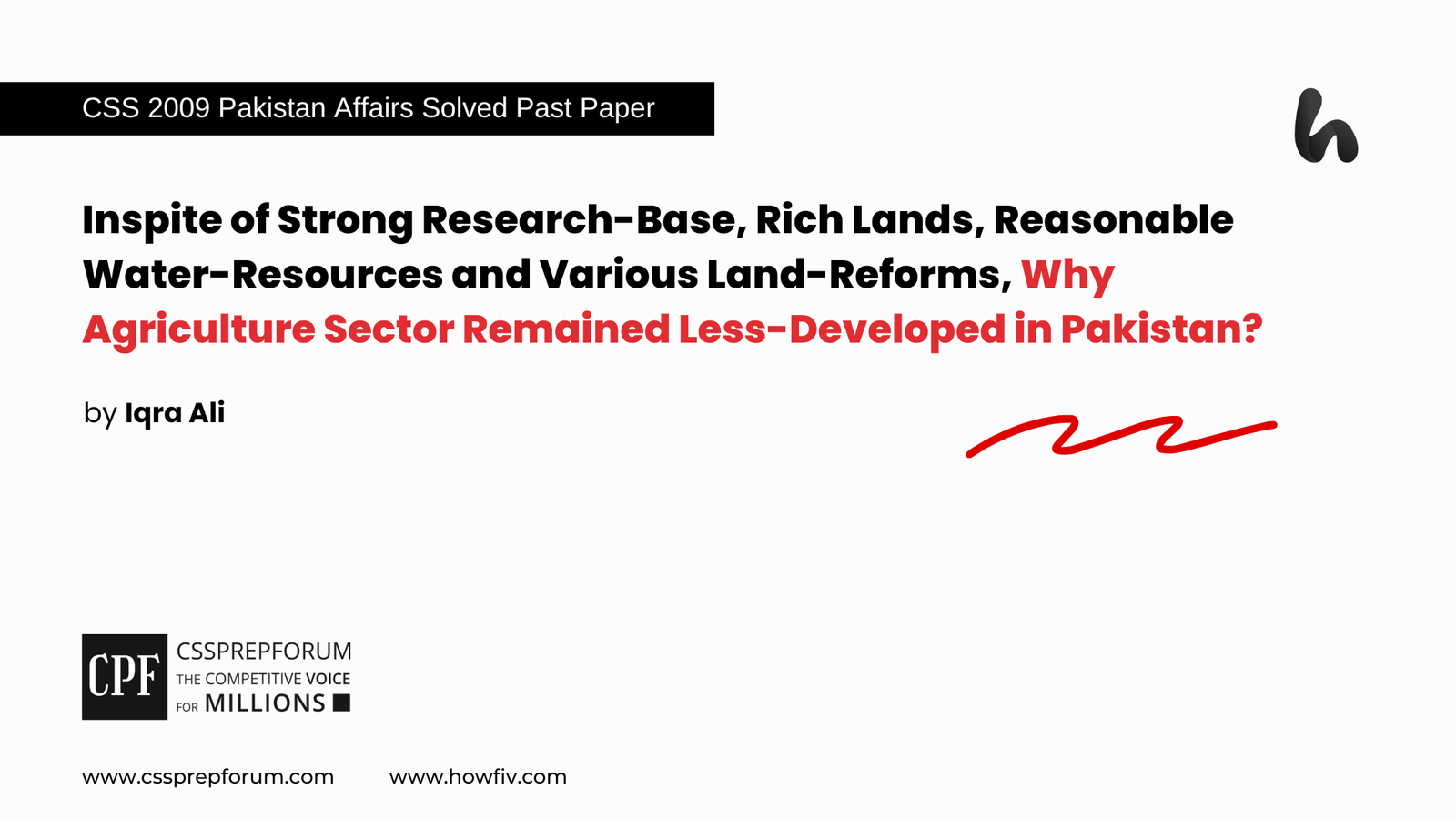CSS 2022 Solved Essays | Global Trade and Trade Policies of China
Khadija Yaseen, a Sir Syed Kazim Ali student, has attempted the CSS 2022 essay “Global Trade and Trade Policies of China” on the given pattern, which Sir Syed Kazim Ali teaches his students. Sir Syed Kazim Ali has been Pakistan’s top English writing and CSS, PMS essay and precis coach with the highest success rate of his students. The essay is uploaded to help other competitive aspirants learn and practice essay writing techniques and patterns to qualify for the essay paper.

Outline
1- Introduction
- ✓ The world’s transformation from a secluded and self-contained landscape to an interconnected one holds immense significance.
- ✓ This metamorphosis has broken down the barriers of isolation and fostered a more unified and integrated world through the wings of trade.
- ✓ China’s transformation from an isolated agrarian economy to a global economic powerhouse hinges upon its vigorous involvement in international trade.
3- Understanding the term global trade
4- The bird’s eye view of the trade policies of China and its journey towards global trade
5- How have China’s trade policies become a threat to global trade?
- ✓ Leading towards trade imbalances and surplus between China and its trade partners due to its export-led oriented growth policy, causing imbalances in international trade
- Case in point: In 2021, China’s exports to the United States accounting for $435.8 billion, while its imports from the USA consisting $123.7 billion, resulting in a trade surplus of $312.1 billion
- ✓ Causing exchange rate variation with other countries due to its policy currency devaluation, leading towards global trade distortions
- Case in point: In August 2015, China devaluing its currency by nearly about 4% against the U.S. dollar, harming other countries’ industries and trade competitiveness
- ✓ Posing challenges to foreign companies operating in China for its lax enforcement of intellectual property rights policy, undermining trust and innovation in global trade
- Case in point: For example, in 2019, the U.S. Department of Justice charging Chinese tech giant Huawei, with stealing trade secrets from T-Mobile
- ✓ Distorting global markets and leading unfair competition for foreign businesses by using policy of subsidizing domestic industries, hampering the trade of international industries
- Case in point: China’s state subsidies to its steel industry resulting in excess production and dumping of cheap steel on the global market, leading to adverse effects for steel companies of other countries
- ✓ Shrinking global trade practices on behalf of protectionist policies, hindering the flow of goods and services between countries
- Case in point: According to the World Trade Organisation, bilateral tariffs have increased on average 17% between the US and China due to protectionism.
- ✓ Causing uncertainty in global markets and disruption in the global supply chain because of abrupt changing in trade policies based on trade disputes
- Case in point: The country’s recent abrupt policies, including China’s implementation of Solar panel Export restrictions and Suspension of Australian Coal Imports
- ✓ Exploiting trading partners through its approach of establishing joint ventures with Chinese companies
- Case in point: China’s major trading partners, including the US and the EU criticising using forced technology transfer to pursue the goals of MiC2025
6- How can the world counter China’s trade policies to save international trade from the negative consequences of these policies?
- ✓ To strengthen multilateral institutions, such as WTO, to address unfair trade practices in China
- ✓ To make China accountable at international level for abolishing trade rules defined by WTO
- ✓ To resolve trade disputes, particularly between China and the USA, to promote free trade agreements and ease tariffs and trade barriers
7- Critical Analysis
8- Conclusion

The world’s transformation from a secluded and self-contained landscape to an interconnected one holds immense significance in the course of human history. In fact, this metamorphosis has broken down the barriers of isolation and fostered a more unified and integrated world through the wings of trade. Undoubtedly, trade, the driver of the world economy, has unlocked a myriad of opportunities by turning oceans into bridges and expanding borders beyond horizons to ensure the dissemination of a nation’s products in international markets. Moreover, it has played a pivotal role in rescuing countries from the clutches of economic stagnation and propelling them towards the pinnacle of progress. For example, China’s transformation from an isolated agrarian economy to a global economic powerhouse hinges upon its vigorous involvement in international trade. Additionally, the nation’s entry into international markets has proved a blessing for the country, making it the world’s biggest economy. However, the trade policies of the communist state have turned out as a double-edged sword. On the one hand, its policies have made China the world’s largest economy; on the other hand, its state-centric trade policies have become a threat to global trade in numerous ways. To begin with, the export-led-oriented growth policy begets trade imbalances amongst its trading partners, causing disruption in international markets. Moreover, its policy of the devaluation of the yuan and lax enforcement of intellectual property rights harm foreign companies’ interests and undermine their trust to invest in the global marketplace. In addition, the Chinese policy of subsidising its domestic industries, along with its protectionist policies, triggers unfair competition for foreign businesses, snatching the international industries’ profits. Further, the abrupt changes in its trade policies due to the ongoing trade war and the nation’s policy of joint ventures with Chinese firms prompt uncertainty in international markets and disruption in global supply chains. Therefore, the world must stand together and take pragmatic measures to save global trade from the negative consequences of such trade policies. Addressing China’s unfair trade practices, making the country accountable at the international level, and resolving trade disputes are some steps to counter China’s unfair trade practices.
The term global trade refers to the exchange of goods and services across the national border. It facilitates the movement of goods, ideas, technology, and resources among countries. It has become a fundamental aspect of the global economy by promoting economic growth, encouraging foreign investment, and creating job opportunities. In fact, international trade, the lifeblood of the world economy, allows different countries to expand their markets through imports and exports. For example, China, India, Japan, and Mexico have gained unprecedented economic growth by opening their markets to global trade. According to the report of the United Nations Conference on Trade and Development, in 2021, the global trade value of goods exported throughout the world amounted to approximately 22.3 trillion U.S. dollars in comparison to 6.45 trillion U.S. dollars in 2000. This is partly because the world economy thrives on the phenomenon of interconnectedness and dependence on each other for economic purposes. Hence, the term global trade has emerged as a fundamental pillar of interconnected economies that build nations together.
Although the trade policies of the People’s Republic of China have reshaped the nation’s destiny and propelled it to become the world’s largest economy, they have also thrown down the gauntlet to the global trade dynamics. Moreover, their trade policies have become a threat to global trade in numerous ways because of the far-reaching consequences of these partial trade practices.
To begin with, Beijing has become one of the world’s largest exporters on the basis of its export-led-oriented growth policy. The country has progressed a lot in international markets by pursuing its exports throughout the world and suppressing imports from other countries into its market. This unbalanced Chinese approach has given birth to trade imbalances and surplus between its trading partners. For example, In 2021, China’s exports to the United States accounted for $435.8 billion dollars, while its imports from the Superpower consisted of $123.7 billion, resulting in a trade surplus of $312.1 billion. In fact, the outcomes of such policies lead the importing countries to a vicious cycle of trade deficits, economic crises, and trade imbalances. Hence, the expansion of the country’s export sector and the suppression of the import sector have consistently exploited the interests of its trading partners, undermining the nation’s trust in international markets.
Not only has the export-oriented policy become a challenge for global trade, but its practice of devaluing the yuan has also become a stumbling block in trade activities. The unequal and biased approach of Beijing triggers inequality at the international level because it makes Chinese exports cheaper in markets and exploits other countries’ demand by exporting cheaper goods. For instance, in August 2015, China devalued its currency by nearly 4 per cent against the U.S. dollar. Unfortunately, such practices result in unfair competition in global markets and erode the profits of other nations, leading the nations to move away from the international market. China’s refusal to adopt the market-oriented exchange rate policy affects the global economy, capital flows, and financial stability.
In addition to currency manipulation, intellectual property theft acts as a roadblock in global trade activities. It poses challenges to foreign companies that are operating in the world’s largest economy. It undermines the foreign companies’ spirit to invest and work in other countries, hampering the international trade dynamics. In fact, the country’s legal system does not adequately protect trade secrets, so foreign companies have expressed concerns that this practice leads to the loss of their technological advantages and potential I.P. theft. For instance, in 2019, the U.S. Department of Justice charged Chinese tech giant Huawei with stealing trade secrets from T-Mobile. Hence, such types of illegal actions diminish the trust of trading partners and halt innovation in global trade.
Besides the lax enforcement of intellectual property rights, the country also hampers international trade by using its policy to subsidise domestic industries. This approach gives Chinese industries a cost advantage by allowing them to sell goods at lower prices in international markets. Ironically, it leads to overproduction and surplus in certain industries, prompting global market imbalances and disrupting the stability of international markets. For instance, China’s state subsidies to its steel industry result in excess production and dumping of cheap steel in the global market, leading to adverse effects for steel companies of other countries. This policy snatches the job opportunities in other countries’ industries that are unable to compete with the subsidised prices due to goods’ flood in international markets. In short, the Chinese subsidisation policy negatively affects balanced international trade by distorting market prices and provoking trade disputes.
Moreover, Beijing’s protectionist policies have become a threat to international trade. Under this approach, the country implements various tariffs, quotas, and import restrictions that limit foreign goods and services’ access to its market. These protectionist practices lead other trading partners to impose trade barriers in response, halting the smooth flow of international trade. For instance, according to the World Trade Organisation, bilateral tariffs have increased on average 17% between the U.S. and China due to protectionism. This tit-for-tat approach escalates trade wars, disrupting trade flows and causing economic uncertainties. Thus,such types of trade barriers serve as a bottleneck in the smooth functioning of global trade by reducing free trade agreements and disrupting the global supply chain.
In addition to the protectionist policies, the abrupt changes in trade policies due to trade disputes amongst its trading partners have become a backlash against international trade. This approach creates uncertainty in global markets and disruption in the global supply chain. For instance, China’s swift decision to implement export restrictions on solar panels and the suspension of Australian Coal Imports have raised chaos in the markets. The nation’s practices based on vested interests hamper the flow of exports and imports, halting countries from involvement in an interconnected global economy and becoming a threat to international trade.
Last but not least, another aggressive approach includes the condition of joint ventures for trading partners. This policy compels foreign investors and businessmen to share their technological data, outcomes of research, and advanced robotic techniques in order to get access to the world’s largest economy companies. This condition exploits the interest of trading partners and fuels tension among them. For example, China’s major trade partners, including the USA and the E.U., have criticised the former for using forced technology transfer tactics to pursue Made in China 2025 goals, leading to the escalation of the Trade war. In fact, the condition also limits foreign direct investment and affects the economic cooperation of nations.
Although China’s trade policies have become a threat to international trade, taking stagnant measures to counter this threat can turn out to be a bright point in the realm of trade. To begin with, strengthening multilateral institutions, such as the World Trade Organisation, to address China’s unfair trade practices can compel the nation to stop such aggressive policies and ensure the acceptance of international trade rules. In addition to this, making the state accountable for abolishing trade rules can lead to a decline in its aggressive actions, encouraging trading partners to participate fearlessly in global markets. At last, resolving trade disputes, particularly between China and the USA, would encourage countries to reduce trade barriers, engage in long-term trade partnerships, and promote free trade agreements. Hence, the world’s cooperation to address these challenges in global trade dynamics can overcome the backlash against the multiculturalism trading system.
In a nutshell, the trade policies of the world’s largest economic power have badly impacted international trade. Some of its policies include export-led oriented growth, currency devaluation, and lax enforcement of intellectual property rights, causing trade imbalances, creating disruptions in global supply chains, and escalating trade tensions among countries. Not only this, but the escalation in the Trade War between the USA and the communist state countries led to uncertainty and chaos in the global marketplace. It fits the fact that the higher the aggressive trade policies, the higher the negative impacts on global trade. To counter it, addressing China’s aggressive strategies in trade dynamics through the World Trade Organisation(WTO) has become the need of time to save the golden opportunity of economic growth from the negative consequences of Chinese policies.
CSS Solved Past Papers’ Essays
Looking for the last ten years of CSS and PMS Solved Essays and want to know how Sir Kazim’s students write and score the highest marks in the essays’ papers? Then, click on the CSS Solved Essays to start reading them.
CSS Solved Essays
CSS 2022 Solved Essays
Are you searching for CSS 2022 solved essays by Sir Syed Kazim Ali’s students? Click on any of the topics to start reading the solved essays.
| 1- | An analysis of the concept of globalization of markets. |
| 2- | Digital democracy: social media and political participation. |
| 3- | Global trade and trade policies of China. |
| 4- | “Imagination is more important than knowledge”. |
| 5- | Global politics and international relations. |
| 6- | The controversial issues of feminism in contemporary women’s rights movements. |
| 7- | World food systems: the economics of agriculture. |
| 8- | Is there such a thing as ethical consumerism? |
| 9- | Human development and economic sustainability. |
| 10- | How are terrorism and its perception shaped by the Mass Media? |
CSS Solved General Science & Ability Past Papers
Want to read the last ten years’ General Science & Ability Solved Past Papers to learn how to attempt them and to score high? Let’s click on the link below to read them all freely. All past papers have been solved by Miss Iqra Ali & Dr Nishat Baloch, Pakistan’s top CSS GSA coach having the highest score of their students. General Science & Ability Solved Past Papers
Articles Might Interest You!
The following are some of the most important articles for CSS and PMS aspirants. Click on any to start reading.












